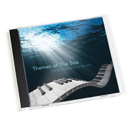 |
 |
|
|
|
|
Articles
Does the Idea of improvisation scare you? Don’t feel alone. During the demonstration I asked for a volunteer out of an audience of 30 or 40 teachers. I couldn’t believe it! It was like pulling teeth. Nobody wanted to come up. Finally, one of the students in the group came up, and as kids do …. Proceeded to improvise fearlessly. I was amazed to see that so many teachers themselves had “Improvphoebia”. On the other hand, it makes sense when you consider most teachers were taught the traditional “Classical” method of playing piano, where improvisation is a topic restricted to Jazz Musicians, or taboo altogether. The irony is, many of the great Western Classical Pianist of the eightieth and ninetieth centuries, who were also teachers, encouraged improvisation as a foundation for more advanced studies. In his book “Great Pianist On Piano Playing, James Cooke Highlights many of the Great Masters Comments and Opinions on the subject. Franz Scharwenka a well-known European Classical Pianist in the eighteen hundreds, writes, “The child is taken to the piano and a peculiar set of hieroglyphics known as notation is displayed to him. He is given a few weeks to comprehend that these signs refer to certain keys on the keyboard. He commences to push down these keys faithfully and patiently and his musical education is thus launched in what many consider the approved manner. Nothing is mentioned about the meaning of the piece, it’s rhythm, it’s harmonies, and it’s aesthetic beauty. It would be just about as sensible to repeat the sounds of the Chinese language by reading the Chinese word-signs, but without comprehending the meaning of the sounds and signs”. A point well taken is, that learning to improvise freely can develop these neglected steps in music education. Simply by exploring various rhythmic, melodic and Harmonic (chords) ideas, even novice players can begin to appreciate the architecture of musical composition and all it’s vast possibilities. Scharwenka goes on to say, “The training of the ear is of great importance, and if teachers would only make sure that their pupils studied music with a sense of hearing as well with their fingers, much time would be saved in later work”. Training of the ear develops “musical intuition”, and is the basis of playing from your heart instead of your head. Improvisation is a fun way to exercise your ear and your trust. So what is Improvisation? Wow! That kind of goes against the traditional grain, \wouldn’t you say. To understand improvisation first hand, find your basic toddler and watch how they approach music. (One of my favorite things in life is watching my two-year-old daughter making music) For most adults improvisation is an unlearning process: Why these obstacles and shadows of our passed haunt us is another subject altogether, and could involve some extensive therapy. For now a good starting place is to get serious about having some fun! Tips on improvising: Find someplace you feel comfortable with and can let your inhibitions go…Yes.. you can bring you keyboard into the bathroom. The acoustics are great! In general improvisation is played over a “Form” such as a series of chords (Chord Progressions) Try these progressions in the key of C. C, F, G., also known as the 1,1V,V progression. (The roman numerals represent which note of the scale the chord is constructed from) Play one measure of each chord with your left hand and establish a firm beat with the chords. You can now start to explore with the right hand by using the notes of the key of C (all white notes). Go slow and always remember to play, as you would speak. Think of sentences and pauses in your dialogue.
As you begin to improvise will discover sounds you like and sounds you don’t like as much. Go with what turns you on and throw out the rest. This way you will start to develop your own style. The main thing to remember is to give you permission to be creative. Keeps it simple, and don’t judge yourself. Make this a sacred time to explore your inner feelings and express them through the music. —Donn Rochlin, Professional Speaker, Teacher, Composer, Musician
|
|
“It’s really great to know I can make more progress than I ever thought possible!” Jim Keesey “Donn Rochlin’s Piano class has enriched my skills as an accompanist, singer/songwriter, and music educator. His Heather Hutton |


